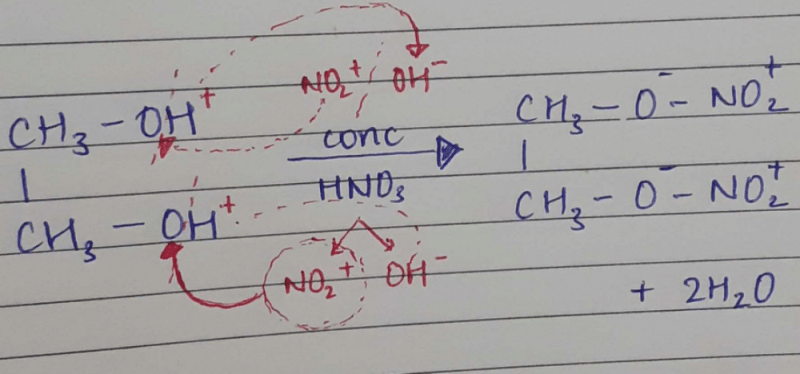NEET Exam > NEET Questions > When ethylene glycol reacts with concentrated...
Start Learning for Free
When ethylene glycol reacts with concentrated nitric acid then what product is formed?
Most Upvoted Answer
When ethylene glycol reacts with concentrated nitric acid then what pr...

Community Answer
When ethylene glycol reacts with concentrated nitric acid then what pr...
Reaction of Ethylene Glycol with Concentrated Nitric Acid
Ethylene glycol is an organic compound with the chemical formula C2H6O2. It is a colorless, odorless, sweet-tasting, and viscous liquid that is used in various industrial and commercial applications, including antifreeze and solvents.
When ethylene glycol reacts with concentrated nitric acid, several products are formed depending on the reaction conditions. The primary products of this reaction are:
- Nitric acid esters of ethylene glycol
- Nitro compounds of ethylene glycol
- Carbon dioxide
- Nitrogen dioxide
Nitric Acid Esters of Ethylene Glycol
Nitric acid esters of ethylene glycol are formed when ethylene glycol reacts with concentrated nitric acid in the presence of a catalyst such as sulfuric acid. The reaction is an example of nitration, which involves the substitution of a nitro group (-NO2) for a hydrogen atom on an organic molecule.
The reaction proceeds as follows:
C2H6O2 + HNO3 → C2H5(ONO2)2 + H2O
The resulting nitric acid esters of ethylene glycol are powerful explosives and are used in the production of high-performance explosives such as dynamite and TNT.
Nitro Compounds of Ethylene Glycol
Nitro compounds of ethylene glycol are formed when ethylene glycol reacts with concentrated nitric acid in the absence of a catalyst. The reaction proceeds as follows:
C2H6O2 + 2HNO3 → C2H3(NO2)2O + 2H2O
The resulting nitro compounds of ethylene glycol are used in the production of various organic compounds such as solvents, dyes, and pharmaceuticals.
Carbon Dioxide and Nitrogen Dioxide
During the reaction of ethylene glycol with concentrated nitric acid, carbon dioxide and nitrogen dioxide are also formed as by-products. These gases are produced due to the oxidation of ethylene glycol by nitric acid.
The overall reaction can be represented as follows:
C2H6O2 + 2HNO3 → C2H
Attention NEET Students!
To make sure you are not studying endlessly, EduRev has designed NEET study material, with Structured Courses, Videos, & Test Series. Plus get personalized analysis, doubt solving and improvement plans to achieve a great score in NEET.

|
Explore Courses for NEET exam
|

|
Similar NEET Doubts
When ethylene glycol reacts with concentrated nitric acid then what product is formed?
Question Description
When ethylene glycol reacts with concentrated nitric acid then what product is formed? for NEET 2024 is part of NEET preparation. The Question and answers have been prepared according to the NEET exam syllabus. Information about When ethylene glycol reacts with concentrated nitric acid then what product is formed? covers all topics & solutions for NEET 2024 Exam. Find important definitions, questions, meanings, examples, exercises and tests below for When ethylene glycol reacts with concentrated nitric acid then what product is formed?.
When ethylene glycol reacts with concentrated nitric acid then what product is formed? for NEET 2024 is part of NEET preparation. The Question and answers have been prepared according to the NEET exam syllabus. Information about When ethylene glycol reacts with concentrated nitric acid then what product is formed? covers all topics & solutions for NEET 2024 Exam. Find important definitions, questions, meanings, examples, exercises and tests below for When ethylene glycol reacts with concentrated nitric acid then what product is formed?.
Solutions for When ethylene glycol reacts with concentrated nitric acid then what product is formed? in English & in Hindi are available as part of our courses for NEET.
Download more important topics, notes, lectures and mock test series for NEET Exam by signing up for free.
Here you can find the meaning of When ethylene glycol reacts with concentrated nitric acid then what product is formed? defined & explained in the simplest way possible. Besides giving the explanation of
When ethylene glycol reacts with concentrated nitric acid then what product is formed?, a detailed solution for When ethylene glycol reacts with concentrated nitric acid then what product is formed? has been provided alongside types of When ethylene glycol reacts with concentrated nitric acid then what product is formed? theory, EduRev gives you an
ample number of questions to practice When ethylene glycol reacts with concentrated nitric acid then what product is formed? tests, examples and also practice NEET tests.

|
Explore Courses for NEET exam
|

|
Suggested Free Tests
Signup for Free!
Signup to see your scores go up within 7 days! Learn & Practice with 1000+ FREE Notes, Videos & Tests.

























